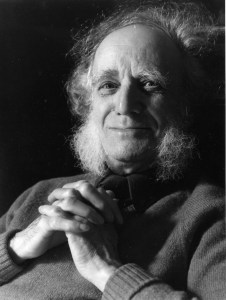Norman Nicholson (1914-87)

Who was Norman Nicholson?
Norman Nicholson was a poet and writer widely regarded as the most important Cumbrian poet of the 20th century. Nicholson was also a prolific reviewer, broadcaster, essayist, anthologist and critic. From 1944 onwards his poetry and drama were published by Faber & Faber, while his topographical writings were published by Robert Hale and Company, London, in the County Book Series and as individual books. He was awarded the first ever Heinemann Prize for Poetry in 1945 for his collection Five Rivers and was elected a Fellow of the Royal Society of Literature in the same year. Further honours followed, including the Cholmondeley Award in 1967, the Queen’s Medal for Poetry in 1977 and an OBE in 1981. Several British universities also honoured him, including the University of Lancaster, which awarded Nicholson an honorary DLitt in 1984. Nicholson’s work was known abroad, especially in the 1940s and 1950s, and a number of his works were translated into other languages, including Italian, Danish, Welsh, Dutch and Russian.
A writer of place and locality
Nicholson’s writing is known for its rootedness and profound sense of place. He was born in Millom, Cumbria, in 1914 and lived in a small terraced house there till his death in 1987, with the exception of a period of nearly two years, from 1930-32, when he was sent to a sanatorium in the New Forest, Hampshire, to recover from tuberculosis. Whilst at school he had been a brilliant scholar, but his illness prevented him taking up a place at university and arguably made him into the writer of locality he eventually became.
Studies of Nicholson’s work
He is now considered to be an ‘environmental writer of some significance’[i] whose work has been the subject of a number of recent studies by David Cooper, Stacey McDowell, Christopher Donaldson, Brian Whalley, Alan Beattie and Andrew Gibson, among others. These, together with two recent biographies, by Kathleen Jones and David Boyd, demonstrate a clear revival of interest in Nicholson’s work. Earlier studies include a full length book by Philip Gardner (1973), a seminal study by Neil Curry (2001), a number of essays by Matt Simpson, and articles or book chapters by John Greening, Daniel Hay, Robin Skelton, Peter Scupham, Anthony Thwaite, A. Trevor Tolley, and William Woodrow (2007), amongst others.
Reputation and relevance
When Faber & Faber published his posthumous Collected Poems (ed. Neil Curry) in 1994, the freelance author and academic Ian Sansom described him as ‘simply, profoundly, a gifted poet’ and with great insight summarized the trajectory of his poetic development as follows:
a recognition of, a coming to terms with, and finally a delight in, the extraordinary rootedness which distinguished him from the globetrotting expats and exiles of literary modernism whom he so admired.
The writer Paul Kingsnorth has written more recently of his realization that Nicholson was a very good and relevant writer, saying that Nicholson’s work fulfils his requirement for a ‘sense of stoicism and realism in the face of the decline of our civilisation, and linked to that a sense of humility and reality about the human place in the world’. More importantly still, Nicholson writes ‘from a place: knowing that place and understanding it […] a sense of writing from beyond metropolis and cosmopolis, the two pole stars of modern culture’.[ii]
The poet and writer Grevel Lindop has said that Norman Nicholson’s writing ‘was valuable and excellent in a wider context, whether you’re interested in Cumbria and the Lakes or not’[iii] and has called him ‘an environmentalist before the word existed’[iv], also praising his ‘vivid colloquial language’, his ‘extraordinary, individual and deep perspective’, and his ability to ‘take the most ordinary-seeming place and make it extraordinary’[v].
Where next for Nicholson Studies?
The Papers of Norman Nicholson are housed in the University of Manchester’s John Rylands Library, Deansgate, Manchester, which has also preserved the Norman Nicholson Book Collection (GB 133 NBK), as well as several related collections. These archival materials are described on a separate page on this website.
Browsing the past issues of Comet made available on this website, or looking in detail at specific articles, will help today’s readers, students and academics to gain a sense of the quality and scope of Nicholson’s work.
[i] Kathleen Jones, Norman Nicholson: The Whispering Poet, Appleby: The Book Mill 2013, p. 232.
[ii] Paul Kingsnorth, ‘Out on the Stubborn Skerry’, 2010 [Accessed 17 January 2019]. Available from: https://web.archive.org/web/20131005004425/http:/dark-mountain.net/out-on-the-stubborn-skerry/
[iii] Grevel Lindop, ‘Norman Nicholson – An Essential Poet‘, 2013 [Accessed 17 January 2019]. Available from : https://grevel.co.uk/poetry/norman-nicholson-essential-poet/
[iv] Ibid.
[v] Ibid.